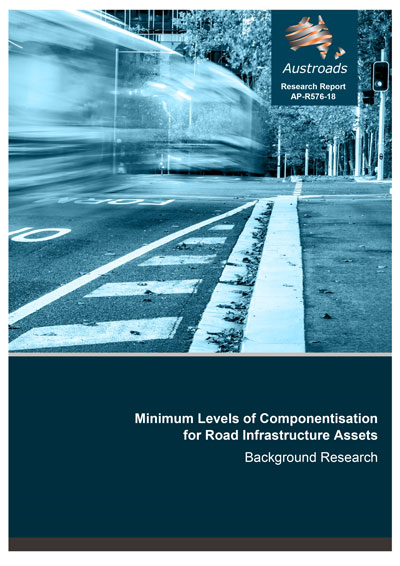Asset Management

- Publication no: AP-R576-18
- ISBN: 978-1-925671-69-8
- Published: 9 August 2018
- PDF (free) Download
This report details the background research that underpins the Minimum Levels of Componentisation for Road Infrastructure Assets: Guideline.
It provides background information to support organisations with implementation of the Guideline and includes an impact statement. It also explains the methodology used, and details the outcomes of the literature review, stakeholder survey and conformance assessment.
The Guideline provides prescriptive minimum levels of componentisation for road infrastructure assets, to enable road authorities to drive improved integration of asset management, financial management and financial reporting. It also provides a benchmark for auditors to drive a more consistent approach to auditing of road agency financial statements.
This, in turn, will enable more efficient collation of national data sets used to enable equitable reform initiatives, such as national funding reform. It is applicable to State / Territory Road Agencies and Local Government Authorities.
- Summary
- 1. Introduction
- 1.1 Project Purpose
- 1.2 Project Scope
- 1.3 Benefits of a Prescriptive Guideline
- 2. Methodology
- 2.1 Staged Deliverables
- 2.2 Project Working Group
- 3. Deliverables Overview
- 3.1 Project Management Deliverables
- 3.2 Literature Review
- 3.3 Communications and Engagement Strategy
- 3.3.1 Auditing Community
- 3.4 Stakeholder Survey Report
- 3.5 Research Report
- 3.6 Alignment Assessments
- 3.6.1 Alignment with other Austroads Reports
- 3.6.2 Conformance Review against Accounting Standards
- 3.7 Impact Statement
- 3.8 Guideline
- 3.9 Webinar
- 4. Literature Review Summary
- 4.1 Agency-Specific Valuation Manuals
- 4.2 Mandatory Financial Statement Reporting Requirements
- 4.3 Treasury Standards and Guidelines
- 4.4 Recognised Guidelines and Standard
- 4.5 Accounting Standards
- 4.6 Literature Review Key Findings
- 5. Stakeholder Survey Summary
- 5.1 Overall Participation
- 5.1.1 Organisation
- 5.2 Financial/Auditor
- 5.2.1 Experience
- 5.2.2 Current Practices
- 5.2.3 Materiality, Capitalisation and Decision Making
- 5.3 Technical/Engineering
- 5.3.1 Organisation Details
- 5.3.2 Asset Type Gross Replacement Values and Organisation Size
- 5.3.3 Predominant Item Definition Approach
- 5.4 Stakeholder Survey Key Findings
- 5.1 Overall Participation
- 6. Discussion and Determinations
- 6.1 Discussion
- 6.1.1 Perspective
- 6.1.2 Materiality and Extracting Benefits
- 6.2 Determinations
- 6.2.1 Asset Classification Structure
- 6.2.2 Floating Item
- 6.2.3 Minimum Inventory Data Requirements
- 6.2.4 Minimum Levels of Componentisation – top three levels
- 6.2.5 Draft Guideline Principles
- 6.1 Discussion
- 7. Alignment Assessments
- 7.1 Alignment with other Austroads Reports
- 7.2 Conformance Review against Accounting Standards
- 8. Guideline
- 8.1 Stand-alone Guideline
- 8.2 Guideline Content
- 8.3 Key Guideline Content
- 8.3.1 Who Is This Guideline For?
- 8.3.2 Core Content of this Guideline
- 8.3.3 Minimum Requirements
- 8.3.4 Expected Benefits
- 8.3.5 Principles
- 8.3.6 Asset Classification Structure
- 8.3.7 Key Guideline Elements
- 8.3.8 Level of Item Recognition
- 8.3.9 Reporting and Outcomes
- 9. Impact Assessment and Transition Statement
- 9.1 Organisation Size vs Valuation Approach
- 9.2 Impact Categories
- 9.3 Impact Assessment
- 9.3.1 Relative Impact Assessment
- 9.3.2 High Level Implementation Considerations
- 9.3.3 Detailed Impact Assessment
- 9.4 Transition Statement
- References
